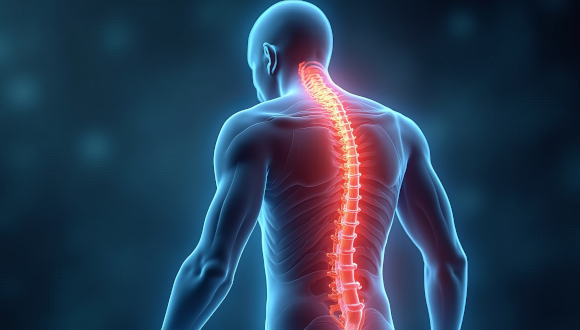Surgeons to implant spinal cord bioengineered at TAU

Patient's own cells may provide cure for paralysis
Support this researchSurgeons in Israel will soon implant a bioengineered, personalized human spinal cord into a paralyzed patient, with the goal of enabling the patient to rise from a wheelchair and walk again.
The research behind this medical advance was led by Professor Tal Dvir, Head of the Sagol Center for Regenerative Biotechnology and Head of the Nanotechnology Center at Tel Aviv University (TAU) and Chief Scientist of the biotech company Matricelf.
A few months ago, Professor Dvir and his research team at Matricelf received preliminary approval from Israel’s Ministry of Health to begin “compassionate use” trials in eight patients, which means that the first patient in the world to undergo this innovative procedure would be Israeli. “This is undoubtedly a matter of national pride,” Professor Dvir says. “The technology was developed here in Israel, at TAU and at Matricelf, and from the very beginning it was clear to us that the first-ever surgery would be performed in Israel, with an Israeli patient.”
The upcoming spinal cord implant surgery marks the next stage in a process that began about three years ago, when Professor Dvir’s lab at TAU succeeded in engineering a personalized three-dimensional human spinal cord in the laboratory. The groundbreaking findings were published in the journal Advanced Science and demonstrated that mice suffering from chronic paralysis and treated with the engineered implants started walking once again.
Following this success, the technology moved into commercial development at Matricelf, a biotech company founded in 2019 based on the revolutionary organ-engineering technology developed by Professor Dvir and his team at TAU, under a licensing agreement through Ramot, TAU’s technology transfer company. Professor Dvir co-founded Matricelf together with Dr. Alon Sinai, and the scientific development is led by Dr. Tamar Harel-Adar and her team.
“The spinal cord is composed of nerve cells that transmit electrical signals from the brain to all parts of the body,” Professor Dvir explains. “The decision is made in the brain, the electrical signal passes through the spinal cord, and from there, neurons activate the muscles throughout the body. When the spinal cord is severed due to trauma, such as a car accident, a fall, or a combat injury, this chain is broken. Think of an electrical cable that has been cut: when the two ends no longer touch, the electrical signal cannot pass. The cable will not transmit electricity, and the person cannot transmit the signal beyond the injury.
“This is one of the very few injuries in the human body that has no natural regenerative ability,” he continues. “Neurons are cells that do not divide and do not renew themselves. They are not like skin cells, which can heal after injury, but are more like heart cells: once damaged, the body cannot repair them. As a result, the damage only worsens until it eventually stabilizes at a very significant level. Over time, the damaged area becomes scar tissue, preventing signals from passing through. The patient remains paralyzed below the site of injury. If the injury is in the neck, all four limbs may be paralyzed. If in the lower back, the legs will not move, and so on.”
With the new technology, the research team aims to engineer a spinal cord that functions exactly like a natural one, enabling the implantation of the engineered tissue into the damaged area. The scar tissue is removed, the engineered spinal cord is implanted, and ultimately, fusion occurs between the new tissue and the healthy areas above and below the injury. The Matricelf team conducted a series of trials in rats, who regained the ability to walk normally.
To ensure successful transplantation, the researchers take blood cells from the patient and perform a process known as reprogramming: genetic engineering that transforms the cells into embryonic stem cell-like cells, capable of developing into any cell type in the body. In the next step, the scientists take fatty tissue from the patient, extract key components such as collagens and sugars, and build a customized hydrogel. The embryonic stem cell-like cells are placed in this gel, and the embryonic development of a spinal cord is mimicked.
“We submitted our findings to the Ministry of Health in Israel and explained our process,” Professor Dvir says. “About six months ago, we received preliminary approval to begin compassionate use trials in eight patients. Since then, we have also received further approval to begin the blood collection process once the first patient is selected and approved. We are highly confident in this process. Our goal is to help paralyzed patients rise from their wheelchairs. The animal model trials showed extraordinary success, and we are hopeful that the results in humans will be just as promising.”
“This milestone marks the shift from pioneering research to patient treatment,” says Gil Hakim, CEO of Matricelf. “For the first time, we are translating years of successful preclinical work into a procedure for people living with paralysis. Our approach, using each patient’s own cells to engineer a new spinal cord, eliminates key safety risks and positions Matricelf at the forefront of regenerative medicine. If successful, this therapy has the potential to define a new standard of care in spinal cord repair, addressing a multi-billion-dollar market which has no effective solutions today.”
See coverage of this story on Facebook: https://www.facebook.com/share/v/1AdVq9yEFB/